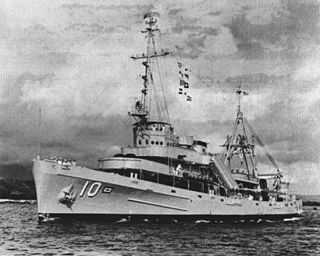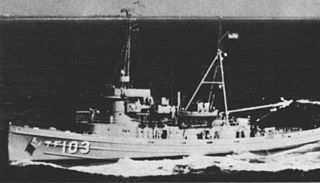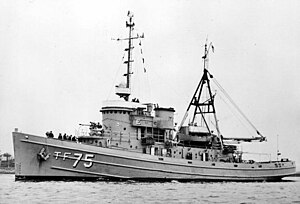
USS Douglas H. Fox (DD-779) was an Allen M. Sumner-class destroyer of the United States Navy.

USS Abnaki (ATF-96) was the lead ship of the Abnaki class of fleet ocean tugs in the service of the United States Navy, named after the Abenaki tribe of Native Americans. She was laid down on 28 November 1942 at Charleston, South Carolina by Charleston Shipbuilding & Drydock, launched on 22 April 1943, sponsored by Mrs. James Mayon Jones, and commissioned at the Charleston Navy Yard on 25 November 1943. Abnaki earned three battle stars for service during the Korean War and 10 battle stars during the Vietnam War.

USS Collett (DD-730) was a World War II-era Allen M. Sumner-class destroyer in the service of the United States Navy.

USS Mullany (DD-528), a Fletcher-class destroyer, was the second ship of the United States Navy to be named for Rear Admiral James Robert Madison Mullany (1818–1887).

USS Munsee (AT/ATF-107) was an Abnaki-class fleet ocean tug. She is the only ship of the United States Navy to hold the name Munsee, which is the name of a subtribe of the Delaware Indians, still living in Wisconsin and Kansas.

USS O'Brien (DD-725), an Allen M. Sumner-class destroyer, was the fourth ship of the United States Navy to be named after Captain Jeremiah O'Brien and his five brothers, Gideon, John, William, Dennis and Joseph, who captured HMS Margaretta on 12 June 1775 during the American Revolution.

USS Tulare (AKA-112/LKA-112) was a Tulare-class attack cargo ship in service with the United States Navy from 1956 to 1986. She was sold for scrap in 2011.

USS Rowan (DD-782) was a Gearing-class destroyer of the United States Navy, the fourth Navy ship named for Vice Admiral Stephen C. Rowan (1805–1890).

USS Lenawee (APA-195) was a Haskell-class attack transport in service with the United States Navy from 1944 to 1946 and from 1950 to 1967. She was scrapped in 1975.

USS Jason (AR-8) was the fourth of the Vulcan class repair ship of the United States Navy in service from 1944 to 1995, serving in World War II, Korea, Vietnam, and the Gulf War. At the time of her decommissioning, Jason was the oldest ship in continual commission in the United States Navy, and the final ship in continual commission from World War II onward.

USS Terrell County (LST-1157), originally USS LST-1157, was a Terrebonne Parish-class tank landing ship built for the United States Navy in 1952. Named for Terrell County, Texas, and Terrell County, Georgia, she was the only U.S. Navy vessel to bear the name. She was later lent to Greece and subsequently sold to Greece, being renamed Oinoussai (L104) in Greek service.

USS Greenlet (ASR-10) was a Chanticleer-class submarine rescue ship in service with the United States Navy from 1943 to 1970. In June 1970, the ship was transferred to the Turkish Navy, renamed TCG Akin (A-585) and remained in service until 2017.

USS Chickasaw (AT-83/ATF-83) was a Navajo-class fleet tug constructed for the United States Navy during World War II. She served in the Pacific Ocean in World War II and the Korean War, and was awarded six battle stars for World War II and two battle stars during the Korean War.
USS Mataco (AT-86/ATF-86) was a Navajo-class fleet tug constructed for the United States Navy during World War II. Her purpose was to aid ships, usually by towing, on the high seas or in combat or post-combat areas, plus "other duties as assigned." She served in the Pacific Ocean and was awarded five battle stars for World War II, four battle stars for the Korean War, and seven campaign stars for Vietnam War service.

USS Tawasa (AT-92) was a Cherokee-class fleet tug constructed for the United States Navy during World War II. Her purpose was to aid ships, usually by towing, on the high seas or in combat or post-combat areas, plus "other duties as assigned." She served in the Pacific Ocean and had a very successful career marked by the winning of three battle stars during World War II, two during the Korean War, and seven campaign stars during the Vietnam War.

USS Safeguard (ARS-25) was a Diver-class rescue and salvage ship in service with the United States Navy from 1944 to 1947 and from 1952 to 1979. She was then transferred to Turkey where she served as TCG Işın (A-589) until 2017.

USS Page County (LST-1076) was a LST-542-class tank landing ship built for the United States Navy during World War II. Named for counties in Iowa and Virginia, she was the only U.S. Naval vessel to bear the name. Initially known only as LST-1076, the ship was deactivated following the war. Renamed Page County in 1955, the ship was reactivated in 1960 and saw service during the Vietnam War. Decommissioned in 1971, Page County was transferred to the Hellenic Navy and renamed Kriti. Her fate is unknown.

USS Apache (AT-67/ATF-67) was a Navajo-class fleet tug, later fleet ocean tug, in commission in the United States Navy from 1942 to 1946 and from 1951 to 1974. She saw service in World War II, the Korean War, and the Vietnam War.

USS Molala (AT-106/ATF-106) was a US Navy Abnaki-class tugboat, named after the Molala people of Oregon.

USS Hitchiti (ATF-103) was Abnaki-class tugboat during the World War II, Korea and Vietnam. The ship was later sold to Mexico as ARM Chac (R-55). Her namesake is a tribe of Creek Indians who lived in Florida and Georgia. The word "Hitchiti" means "to look up the stream."



















